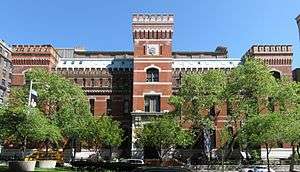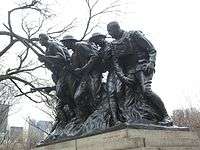107th Infantry Regiment (United States)
| 107th Infantry Regiment | |
|---|---|
|
Coat of arms | |
| Active | 1917–93 |
| Country |
|
| Allegiance | New York |
| Branch | New York Army National Guard |
| Size | Regiment |
| Motto(s) | "Pro Patria et Gloria" (For Country and Glory) |
| Insignia | |
| Distinctive unit insignia |
 |
| U.S. Infantry Regiments | |
|---|---|
| Previous | Next |
| 106th Infantry Regiment | 108th Infantry Regiment |

The 107th Infantry Regiment was a regiment of the New York Army National Guard. The regiment was formed in 1917 and disestablished in 1993.
The 107th traces its history to the Seventh Regiment of New York (or 7th New York Militia/7th Regiment New York State Militia). Known as the "Silk Stockings" for the high number of New York City's social elite among its ranks,[1] it was established in 1806[2] in response to the invasion of New York Bay by warships of the British Navy, whose commanders claimed the right to detain and search American vessels and impress any British subjects serving on them.[3]
Time-line
Source:[2]
- 1806: Established in New York in response to the blockade of New York Bay by British ships. Four companies were formed and assigned to the First Brigade of the Battalion of Artillery.
- 1807–1808: Reorganized as the 2nd Battalion, 3rd Regiment of Artillery, New York State Militia.
- 1812: Redesignated 2nd Battalion, 11th Regiment of Artillery, New York State Militia.
- 1812–1814: Deployed in the harbor forts of New York.
- 1824: Renamed the National Guards (National Guard from 1832) in tribute to the Marquis de Lafayette. Gray uniforms were adopted and the intention to become a regiment was declared.
- 1826: Redesignated as the 27th Regiment of Artillery, New York State Militia.
- 1838: A company of cavalry, Company I, is formed and designated the "First Troop, National Guard"
- 1847: Redesignated the 7th Regiment of Infantry (National Guard), New York State Militia.
- 1849: 7th Regiment suppresses the Astor Place riot.
- 1852: The 7th Regiment Band is organized.
- 1855: The Engineers Corps is organized, later called Company K (1860).
- 1857: The 7th Regiment suppresses two riots, one of which involved the Dead Rabbits and the Bowery Boys.
- 1861: Mustered into federal service.
- 1862: Mustered into federal service in Baltimore.
- 1862: New York State Militia redesignated the New York National Guard.
- 1863: Mustered into federal service in Maryland. Deployed in New York to quell the Draft Riots.
- 1869: The 7th Regiment is deployed during the Orange Riots.
- 1880: The 7th Regiment Armory opens in New York City.
- 1895: The 7th Regiment is called up during the Brooklyn Street-Car Strike.
- 1900: The 7th Regiment is called for guard duty during the Croton Reservoir labor dispute.
- 1916: The 7th Regiment is mustered into federal service to guard the Mexican Border.
- 1917: The 7th Regiment is drafted into federal service.
- 1917: Redesignated the 107th Infantry and assigned to the 27th Division.
- 1917–1919: The 7th Infantry, New York Guard serves as the Depot (Home) Battalion.
- 1921–1922: Consolidates with 7th Infantry, New York Guard, and reorganized and federalized as the 107th Infantry.
- 1940: The 107th Infantry is redesignated the 207th Coast Artillery Anti-Aircraft on 1 August.
- 1940: 7th Regiment, New York State Guard is formed.
- 1943: The Regiment is broken up, reorganized and redesignated as follows:
- HHB as HHB 207th Anti-Aircraft Artillery Group
- 1st Battalion as 771st Anti-Aircraft Artillery Gun Battalion
- 2nd Battalion as 7th Anti-Aircraft Artillery Automatic Weapons Battalion
- 3rd Battalion as 247th Anti-Aircraft Artillery Searchlight Battalion
- 1946–1947: Reorganized as the 107th Infantry with Headquarters in New York.
- 1957: Relieved from 107th Regimental Combat Team, assigned to 42d Infantry Division.
- 1959: Relieved from 42d Infantry Division, reorganized as 107th Infantry, parent regiment under the Combat Arms Regimental System.
- 1993: the 1st Battalion, 107th Infantry, was deactivated as part of nationwide force structure reductions.[4] The 107th designation was reassigned to the former 205th Support Group, New York Army National Guard, creating the 107th Support Group.
Seventh Regiment Band
In 1852 the 7th Regiment Band was organized. A German musical society of the mid-19th century formed the Seventh Regiment Band consisting of forty-two professional German musicians. It was the only exclusively regimental band of the Civil War-era and one of the most popular brass bands of the time; the band-leader, who went by the name Noll, used brass and reed instruments in duo proportion.
In 1860 Claudio S. Grafulla became the band-leader and reorganized the band. He added woodwinds to the band and continued to serve as its director until his death in 1880. The band gained a high reputation under his leadership. He composed and is best remembered for his march, Washington Greys.[5]
The band was honored in 1922 by John Philip Sousa's The Gallant Seventh march. On 18 April 1923, Sousa conducted the band in playing The Star-Spangled Banner at the opening of Yankee Stadium.[6]
Memorial in Central Park
The 107th Infantry Memorial is dedicated to the men who served in the 107th New York Infantry Regiment, originally Seventh Regiment of New York, during World War I. The memorial depicts seven men; the one to the far right carrying two Mills bombs, while supporting the wounded soldier next to him. To his right another infantryman rushes towards the enemy positions, while the helmet less squad leader and another soldier are approaching the enemy with bayonets fixed. To the far left, one soldier is holding a mortally wounded soldier, keeping him on his feet. The bronze memorial was donated by 7th–107th Memorial Committee, and was designed and sculpted by Karl Illava, who served in the 107th IR as a sergeant in World War I. The monument was first conceived about 1920, was made in 1926–1927 and was placed in the park and unveiled in 1927, near the perimeter wall at Fifth Avenue and 67th Street.
Distinctive unit insignia
- Description
A Gold color metal and enamel device 1 1⁄4 inches (3.2 cm) in height consisting of a shield blazoned: Per chevron Gules and Gray, a chevron rompu embattled to chief Argent between in chief the cipher "NG" and a lion rampant Or, and in base a bomb flamant of the last charged with the numeral seven Sable; surmounting a blue circular garter inscribed "PRO PATRIA ET GLORIA" in Gold, buckled Gold and folded at the top and surmounted by a Gold flintlock hammer.
- Symbolism
The original units of the regiment were artillery and the bursting bomb, the earliest insignia, represents that assignment. The old uniform was cadet gray; the monogram "N.G." was worn on it. For over fifty years the 107th Infantry Regiment was the only organization bearing the distinctive title of "National Guard." This designation was adopted by the United States Government for general use in 1869. The rampant lion commemorates service in Picard, France, during World War I. The embattled and broken chevron is emblematic of the breaking of the Hindenburg Line, in which the 107th Infantry Regiment participated. The motto translates to "For Country and Glory."
- Background
The distinctive unit insignia was originally approved for the 107th Infantry Regiment on 26 February 1924. It was amended to correct the description on 28 March 1925. It was redesignated for the 207th Coast Artillery Regiment on 24 October 1940. The insignia was redesignated for the 107th Infantry Regiment on 30 March 1951. It was redesignated for the 107th Support Group with the description and symbolism revised effective 1 September 1993.
Coat of arms
Blazon
- Shield: Per chevron Gules and Gray, a chevron embattled to chief rompu enhanced Argent between in chief the cipher of the regiment of 1824 (the script monogram N.G.) and a lion rampant both Or and in base the cap of 1815 as worn in 1915 (a flaming bomb charged with the number 7 Sable) of the like.
- Crest: That for the regiments and separate battalions of the New York Army National Guard: On a wreath Argent and Gules, the full-rigged ship "Half Moon", all Proper.
- Motto: PRO PATRIA ET GLORIA (For Country and Glory).
Symbolism
- Shield: The original units of the regiment were artillery and the bursting bomb, the earliest insignia, represents that assignment. The old uniform was cadet gray; the monogram "N.G." was worn on it. For over fifty years the 107th Infantry Regiment was the only organization bearing the distinctive title of "National Guard". This designation was adopted by the United States Government for general use in 1869. The rampant lion commemorates service in Picard, France, during World War I. The embattled and broken chevron is emblematic of the breaking of the Hindenburg Line, in which the 107th Infantry Regiment participated.
Background
The coat of arms was originally approved for the 107th Infantry Regiment on 2 August 1923. It was amended to correct the blazon of the shield on 28 March 1925. It was redesignated for the 207th Coast Artillery Regiment on 24 October 1940. The insignia was redesignated for the 107th Infantry Regiment on 30 March 1951. The coat of arms was cancelled on 3 June 1993, when the distinctive unit insignia was redesignated for the 107th Support Group, as the Group was not eligible to inherit the coat of arms.
References
- ↑ Lukasik, Sebastian Hubert, Military Service, Combat, and American Identity in the Progressive Era, p. 84 "The 7th Regiment of the New York National Guard carried on its muster roles the names of so many scions of New York City's social prominent families that it was commonly known as the "Silk Stocking" or "Blue-Blood" Regiment."
- 1 2 "Guide to the Records of the 7th Regiment". The New York Historical Society. 2003. Retrieved 4 May 2014.
- ↑ Clark, Emmons (1890). History of the Seventh Regiment of New York, 1806-1889. Seventh Regiment.
- ↑ Globalsecurity.org, 107th Support Group, accessed June 2013.
- ↑ "The President's Own" United States Marine Band, Hall of Composers
- ↑ Slayton, Robert A. (2001), Empire Statesman: the rise and redemption of Al Smith, The Free Press, New York (ISBN 0-684-86302-2), pages 229–230
Further reading
- Gerald F. Jacobson (1920) History of the 107th Infantry USA 7th Regiment Armory
- Frederick P. Todd (1956) Pro patria et gloria: The illustrated story of the one hundred and fifty years of the Seventh Regiment of New York (107th Infantry Regiment, N.Y.N.G.), Published for the Seventh Regiment by Rampart House.

